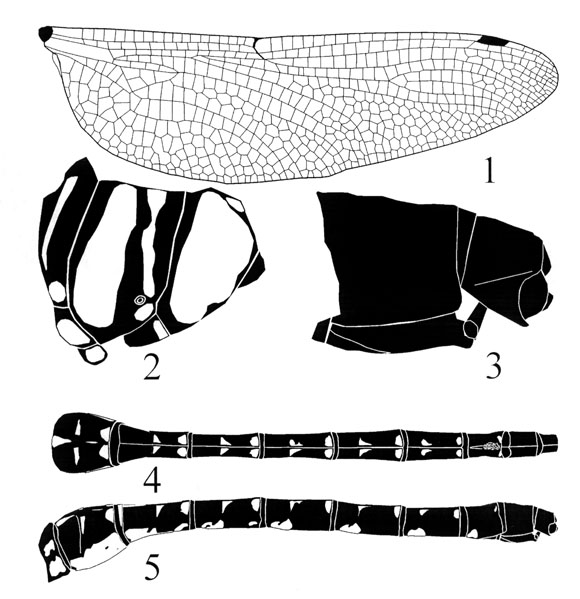
Invertebrates (pdf)
|
Sinthusa nasaka (Horsfield) (Lepidoptera: Lycaenidae), a butterfly new to Hong Kong |
|
New Planaeschna record from Hong Kong (Odonata: Aeshnidae) (pdf)
by Keith DP Wilson
Dragonfly Ecological Services, 18 Chatsworth Road, Brighton, BN1 5DB, UK e-mail: kdpwilson@gmail.com
During late October 2005 I undertook a crepuscular survey of dragonflies at Wu Kau Tang. In the 10-20 minute feeding frenzy which takes place just before dusk, I captured a total of seven aeshnid specimens using a net. Six of the seven specimens were identified as Gynacantha japonica Bartenef and the remaining specimen belongs to the genus Planaeschna McLachlan. It may represent an undescribed species. No previous species of Planaeschna has been recorded from Hong Kong.
The genus Planaeschna is mainly confined to Indo-China with outliers occurring in South China, Thailand, Burma, India (Assam) and Japan. Seven species of Planaeschna have been described from China, which are P. celia Wilson & Reels, 2001 (Hainan), P. gressitti Karube, 2002 (Guangdong), P. maolanensis Zhou & Bao, 2002 (Guizhou), P. risi Asahina, 1964 (Japan & Taiwan), P. shanxiensis Zhu & Zhang (Shanxi), P. suichangensis Zhou & Wei, 1980 (Guangdong, Guangxi & Zhejiang), P. taiwana Asahina, 1951 (Taiwan). In addition, a further five species of Planaeschna have been described from Vietnam. A total of 17 species have been described to date with nine of these named in the last 10 years.
The Hong Kong female Planaeschna does not belong to suichangensis, which is the most widespread and abundant Planaeschna species recorded from Guangdong. Currently the female gressitti is unknown but the abdomen does not have yellow spots, adjacent to the transverse carina, which are linked to basal, ventral yellow spots to form a yellow median from S3-8. This ringed pattern is possessed by male gressitti (Karube, 2002) and in all other Planaeshna species the feature is exhibited by both males and females. The Hong Kong female does not have this feature so is most unlikely to belong to gressitti. Two new species of Planaeschna from central and north Guangdong await description but the Hong Kong female does not belong to either of these new species. It is closest to risi but further specimens are nevertheless required, especially a male, before a clear placement of the Hong Kong Planaeschna can be made. Planaeschna risi was recorded from Guangxi by Wilson (2005) but evaluation of further material from Guangxi and Guangdong indicates this material does not in fact belong to risi, which is endemic to Taiwan and the Ryukyu islands.
The Hong Kong female Planaeschna was collected over abandoned marshy agricultural land at San Uk Ha, Wu Kau Tang on the evening of 30 October 2005. Planaeschna larvae dwell in flowing streams usually in montane, forested areas. Most species are known from altitudes exceeding 500 m. Only one species, described from North Vietnam, Planaeschna cucphuongensis Karube, is known from lowland forest (Karube, 1999). The new Planaeschna species is likely to breed in montane forested tributary streams in the country park surrounding Wu Kau Tang but its larvae may utilize the tributaries or main stream flowing through the Wu Kau Tang basin i.e. the area covered by the Wu Kau Tang Outline Zoning Plan.
Bibliography
Karube, H. (1999). Planeaeschna cucphuongensis spec. nov., a new dragonfly from northern Vietnam (Anisoptera: Aeshnidae). Odonatologica 28(3): 279-282.
Karube, H. (2002). Notes on the Chinese Planaeschna (Odonata: Aeshnidae) deposited in the Natural History Museum, London with description of a new species from Southern China Tombo 44: 1-5.
Wilson, K.D.P. (2005). Odonata of Guangxi Zhuang Autonomous Region, China, part II: Anisoptera. International Journal of Odonatology 8(1): 107-168.
 |
| Figures 1-5 Planaeschna sp., Wu Kau Tang, Hong Kong. (1) Hindwing; (2) synthorax; (3) caudal segments 9-10, lateral [cerci and styles missing]; (4) abdomen segments 9-10, dorsal; (5) abdomen segments 1-10, lateral. |
P.5-6
|
Porcupine! |
 Copyright © 2000 |
